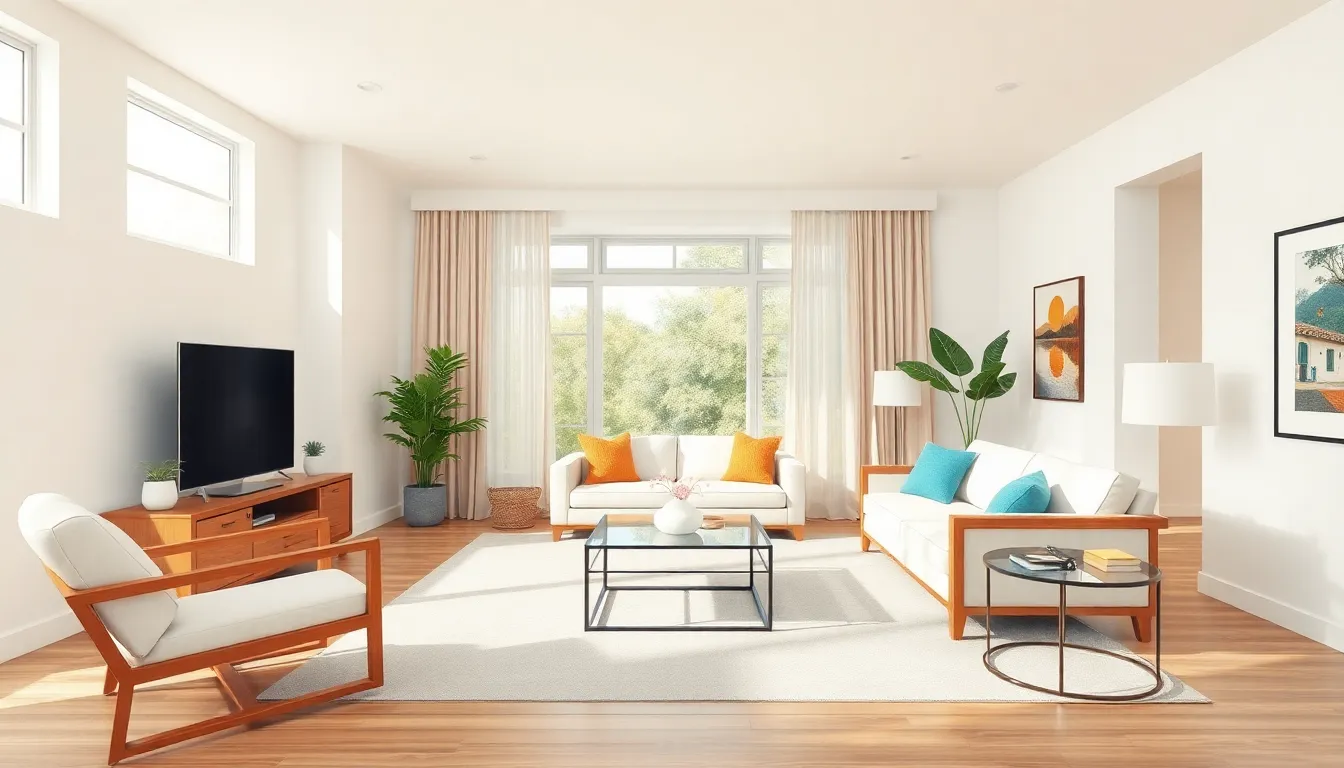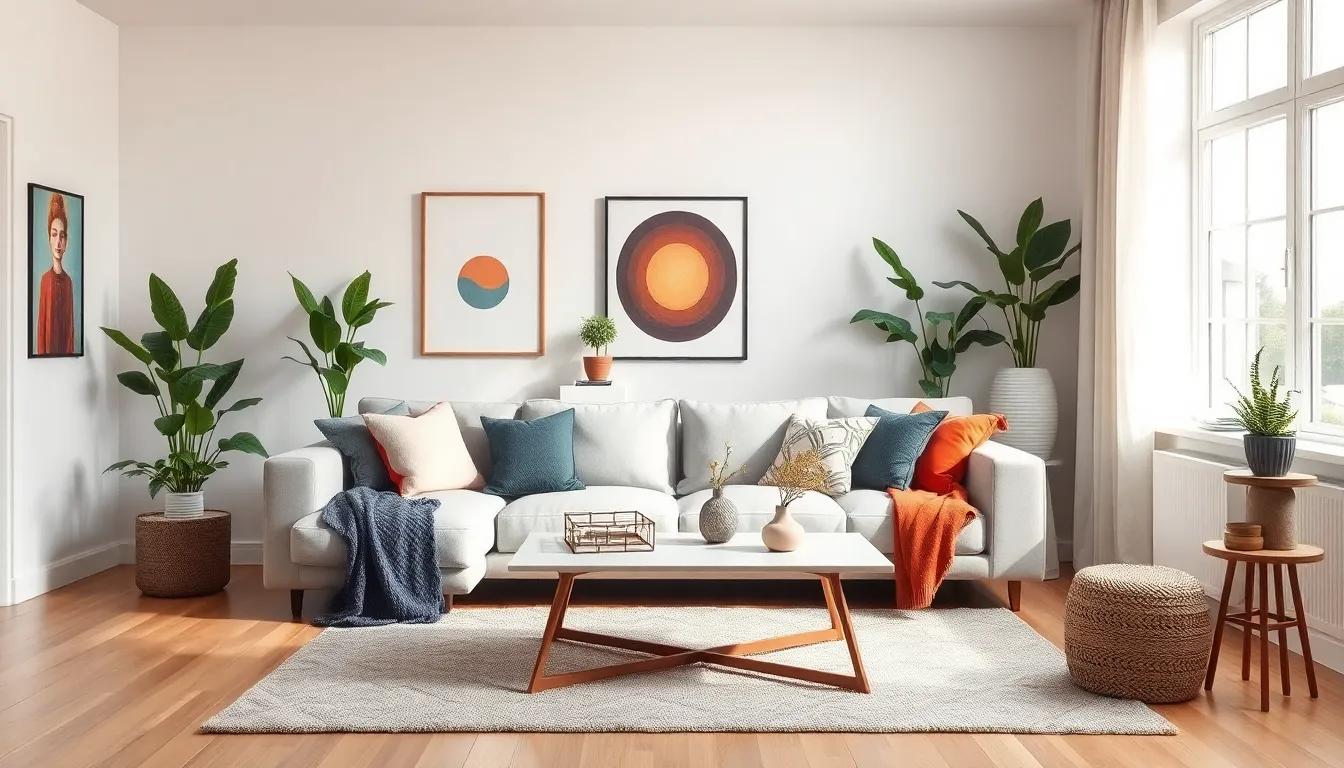Transforming a space isn’t just about slapping a coat of paint on the walls and calling it a day. It’s an art form, a delicate dance between creativity and practicality. Whether it’s a cozy nook or a sprawling living room, the right design and decor can turn the mundane into the magnificent. Think of it as giving your home a personality makeover—one that’ll make your guests say, “Wow, who knew you had such style?”
Table of Contents
ToggleUnderstanding Design and Decor
Transforming a space requires an understanding of both design and decor. Each plays a unique role in creating an inviting atmosphere that enhances the functionality and aesthetics of a home.
The Difference Between Design and Decor
Design focuses on the overall structure and layout of a space. It includes aspects like architecture, spatial planning, and the selection of materials. Decor, on the other hand, emphasizes the finishing touches that provide personality and style. It encompasses elements such as furniture, artwork, and colors. Recognizing this distinction helps individuals achieve a balanced aesthetic by integrating both functional and decorative elements into their space.
Importance of Design in Creating Spaces
Design lays the foundation for a functional environment. It determines flow, accessibility, and how a space is experienced daily. Thoughtful design maximizes natural light, optimizes layout, and accommodates user needs effectively. Without solid design principles in place, decor may fall flat or fail to create a cohesive look. Prioritizing design ensures that spaces are not only visually appealing but also serve their intended purposes efficiently.
Key Elements of Creating Design and Decor

Creating a harmonious design and decor involves several key elements that work together to transform a space effectively. Understanding these elements facilitates the achievement of a balanced aesthetic.
Color Schemes
Colors significantly affect mood and perception in a space. Choosing a color palette involves considering the desired atmosphere, whether it’s calming neutrals or vibrant hues. Coordinating colors with furniture and decor helps maintain cohesion. Utilizing the 60-30-10 rule often results in a visually pleasing composition, with 60 percent being a dominant color, 30 percent a secondary color, and 10 percent an accent color. Testing color samples in natural light ensures they reflect the intended vibe.
Material Selection
Selecting materials creates texture and depth in design. Durable options influence both visual appeal and functionality. Natural materials like wood and stone add warmth, while metal and glass offer a modern touch. Mixing materials can elevate a space, creating visual interest; however, harmony among chosen materials maintains balance. Considering sustainability in material choices supports eco-friendly living, aligning with contemporary design trends.
Furniture Arrangement
Arranging furniture strategically affects flow and functionality. Prioritizing focal points guides placement while allowing an open layout encourages movement. Grouping furniture promotes conversation and interaction, fostering a welcoming atmosphere. Measuring dimensions ensures sufficient space for movement and accessibility. Adapting arrangements to suit diverse activities enhances usability, making a space versatile and inviting.
Popular Design Styles
Exploring popular design styles allows for better understanding of how to create unique spaces. Each style brings distinct characteristics that can transform a home.
Modern Minimalism
Modern minimalism emphasizes simplicity and functionality. Clean lines and uncluttered spaces define this style. Neutral colors dominate the palette, creating an airy and spacious feel. Furniture tends to focus on geometric shapes, integrating seamlessly into the environment. Accessories remain minimal, often consisting of a few carefully chosen decorative items. Natural light gains importance, enhancing the overall ambiance.
Bohemian Chic
Bohemian chic encourages a relaxed, eclectic atmosphere. Vibrant colors and varied patterns fill this style, showcasing a mix of cultures and personal history. Layering fabrics, such as throws and rugs, adds warmth and comfort. Plants frequently feature in bohemian decor, bringing nature indoors. Unique mementos and art pieces tell a story, inviting conversations. Combining vintage and modern elements creates a visually interesting and inviting space.
Industrial Design
Industrial design draws inspiration from warehouses and factories. Exposed brick walls, metal fixtures, and raw materials define the aesthetic. Neutral tones and a mix of textures contribute to character. Open layouts foster social interaction and adaptability. Vintage furniture complements the rugged style, enhancing the overall appeal. Lighting often consists of bold fixtures, adding striking focal points throughout the space.
Tips for Effective Design and Decor
Engaging in design and decor involves thoughtful choices that reflect personal style. Personalizing a space turns it into a true reflection of the occupants’ tastes.
Personalizing Your Space
Integrate elements that showcase individuality. Artwork can provide character, while family photos evoke memories. Choosing unique accessories adds a personal touch, transforming an ordinary space into a signature home. Incorporating favorite colors in accents creates cohesion, enhancing emotional connection. Mix and match textiles for warmth and texture, allowing comfort and aesthetics to coexist. Finally, including plants contributes vibrancy and freshness, promoting a lively atmosphere.
Utilizing Space Wisely
Maximizing space enhances functionality and flow. First, assess the layout to understand how movement occurs. Select furniture that fits scale, ensuring that each piece complements the overall design. Multi-functional items offer versatility, saving space while serving multiple purposes. Use vertical space for storage with shelves, creating an organized environment. Additionally, consider open layouts that promote airflow and light, making the area feel larger. Thoughtful design optimizes each square foot, inviting creativity and ensuring practicality.
Creating design and decor is an art that combines creativity with functionality. It’s about making spaces that not only look good but also feel good and serve a purpose. By understanding the nuances between design and decor, individuals can craft environments that reflect their personality while enhancing everyday experiences.
Incorporating key elements like color schemes, material selection, and strategic furniture arrangement can transform any area into a welcoming haven. Embracing various design styles allows for endless possibilities, ensuring each space tells a unique story. Personal touches elevate the ambiance, making a home truly one-of-a-kind. Ultimately, thoughtful design and decor can inspire and uplift, creating spaces that resonate with beauty and purpose.






